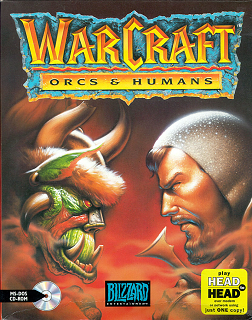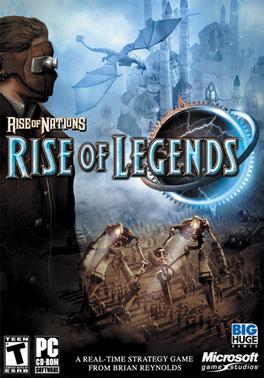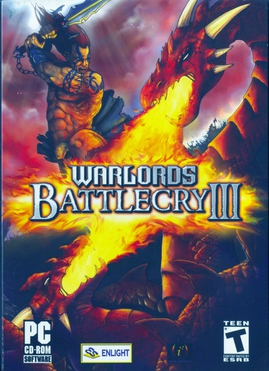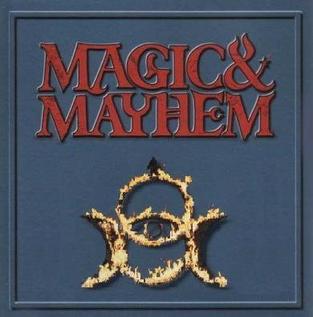
Warcraft III: Reign of Chaos is a high fantasy real-time strategy computer video game developed and published by Blizzard Entertainment released in July 2002. It is the second sequel to Warcraft: Orcs & Humans, after Warcraft II: Tides of Darkness, the third game set in the Warcraft fictional universe, and the first to be rendered in three dimensions. An expansion pack, The Frozen Throne, was released in July 2003. Warcraft III is set several years after the events of Warcraft II, and tells the story of the Burning Legion's attempt to conquer the fictional world of Azeroth with the help of an army of the Undead known as the Scourge, led by fallen paladin Arthas Menethil. It chronicles the combined efforts of the Human Alliance, Orcish Horde, and Night Elves to stop them before they can corrupt the World Tree.

Warcraft: Orcs & Humans is a real-time strategy game (RTS) developed and published by Blizzard Entertainment, and published by Interplay Productions in Europe. It was released for MS-DOS in North America on 15 November 1994, and for Mac OS in early 1996. The MS-DOS version was re-released by Sold-Out Software in 2002.
Real-time strategy (RTS) is a subgenre of strategy video games that does not progress incrementally in turns, but allow all players to play simultaneously, in "real time." By contrast, in turn-based strategy (TBS) games, players take turns to play. The term "real-time strategy" was coined by Brett Sperry to market Dune II in the early 1990s.

Warcraft III: The Frozen Throne is the expansion pack for Warcraft III: Reign of Chaos, a real-time strategy video game by Blizzard Entertainment. It was released worldwide on July 1, 2003, for Microsoft Windows and Mac OS X. The Frozen Throne builds upon the story of Reign of Chaos and depicts the events after the main game's conclusion. The single-player unfolds from the perspective of two new protagonists—the Night Elf warden Maiev Shadowsong and the Blood Elf prince Kael'Thas—as well as returning protagonist Arthas Menethil. Additionally, the expansion contains Act I of a separate Horde campaign that is independent from the main storyline with Blizzard releasing Acts II and III via patch in December 2003, taking in player feedback of Act I when developing these chapters.

Age of Wonders is a 1999 turn-based strategy game co-developed by Triumph Studios and Epic MegaGames, and published by Gathering of Developers.

Dungeon Keeper 2 is a strategy game developed by Bullfrog Productions and published by Electronic Arts in 1999 for Microsoft Windows. In the sequel to Dungeon Keeper, the player takes the role of a 'dungeon keeper', building and defending an underground dungeon from the would-be heroes that would invade it, as well as from other keepers. In the campaign mode, the player is charged with recovering the portal gems from each area in order to open a portal to the surface. The player can also construct a dungeon without strict objectives, and multiplayer is supported over a network.

Heroes of Might and Magic II: The Succession Wars is a turn-based strategy video game developed by Jon Van Caneghem through New World Computing and published in 1996 by the 3DO Company. The game is the second installment of the Heroes of Might and Magic series and is typically credited as the breakout game for the series. Heroes II was voted the sixth-best PC game of all time by PC Gamer in May 1997.

Rise of Nations: Rise of Legends is a science fantasy real-time strategy video game for Microsoft Windows, made by Big Huge Games, and published by Microsoft. It is a spin-off of the popular Rise of Nations, released in May 2006. However, rather than being a historical game, it is based in a fantasy world, where technology and magic co-exist. It was released on May 9, 2006 in North America and on various dates around May 26, 2006 in the rest of the world.

Dungeons & Dragons: Dragonshard is a real-time strategy role-playing video game, developed for Microsoft Windows by Liquid Entertainment, and published by Atari in September 2005. It takes place in Eberron, one of the official Dungeons & Dragons campaign settings. The game combines elements of traditional real-time strategy gameplay with role-playing elements such as hero units, and questing. Dragonshard includes two single-player campaigns, single-player skirmish maps, and multiplayer support. The single-player campaign follows the struggles of three competing factions to gain control of a magical artifact known as the Heart of Siberys.

The Palladium Fantasy Role-Playing Game is a fantasy role-playing game published by Palladium Books in 1983.

Lords of Magic is a turn-based strategy Microsoft Windows game designed for Windows 95/98 by Sierra On-Line. The game was intended to combine elements of Heroes of Might and Magic II and Lords of the Realm II. The special edition also contains the Legends of Urak quest pack, a set of five individual quests that revolve around stories unrelated to the main plot of the game.

The Lord of the Rings: War of the Ring is a 2003 real-time strategy game (RTS) developed by Liquid Entertainment and published by Sierra Entertainment, a subsidiary of Vivendi Universal Games. Set in J. R. R. Tolkien’s fictional Middle-earth, it expands upon the events of the War of the Ring as told in his fantasy novel, The Lord of the Rings.

Glest is a free and open-source real-time strategy computer game from 2004. Glest is set in a medieval fantasy world with two factions, and was compared with Warcraft III and the Empire Earth series. The game received positive to mixed reviews from the press, has been downloaded over two million times, and spawned several derivative continuation projects which are under active development.

Heroes of Mana is a 2007 real-time strategy video game developed by Brownie Brown and Square Enix and published by Square Enix for the Nintendo DS. It is the ninth game of the Mana series and the fourth entry in the World of Mana subseries, following the release of Dawn of Mana three months prior. Set in a high fantasy universe, Heroes of Mana follows a young soldier, Roget, as he journeys to defend several nations from the ruthless aggression of his own country in a series of battles.

Warlords Battlecry III is a real-time strategy game developed by Infinite Interactive and published in 2004. It is the third installment in the Warlords Battlecry series and the sequel to Warlords Battlecry II.
Strategy is a major video game genre that emphasizes thinking and planning over direct instant action in order to achieve victory. Although many types of video games can contain strategic elements, as a genre, strategy games are most commonly defined as those with a primary focus on high-level strategy, logistics and resource management. They are also usually divided into two main sub-categories: turn-based and real-time, but there are also many strategy cross/sub-genres that feature additional elements such as tactics, diplomacy, economics and exploration.

Magic & Mayhem is a fantasy/mythology-themed real-time strategy game designed by Julian Gollop and developed by Mythos Games. It was published by Virgin Interactive Entertainment in late 1998, and by Bethesda soon after in 1999. Although the game received generally positive criticisms, it met a quiet public reception.
Archenemy is a variant of Magic: The Gathering with an emphasis on one vs. many multiplayer games. The set utilizes new oversized Scheme cards. Four game packs were released on June 18, 2010: Assemble the Doomsday Machine, Bring About the Undead Apocalypse, Scorch the World with Dragonfire, Trample Civilization Underfoot. The cards within each preconstructed deck have all been reprinted from various Magic sets, with the exception of one card per deck, that is a new card from Magic 2011. All of the cards are black bordered and tournament legal in their original formats. A sequel, Archenemy: Nicol Bolas, was released in 2017.

Warcraft II: Tides of Darkness is a fantasy real-time strategy computer game developed by Blizzard Entertainment and released for MS-DOS and Microsoft Windows in 1995 and Mac OS in 1996 by Blizzard's parent, Davidson & Associates. A sequel to Warcraft: Orcs & Humans, the game was met with positive reviews and won most of the major PC gaming awards in 1996. In 1996, Blizzard released an expansion pack, Warcraft II: Beyond the Dark Portal, for DOS and Mac OS, and a compilation, Warcraft II: The Dark Saga, for the PlayStation and Sega Saturn. The Battle.net edition, released in 1999, included Warcraft II: Beyond the Dark Portal, provided Blizzard's online gaming service, and replaced the MS-DOS version with a Windows one.

Dungeons 3 is a video game developed by Realmforge Studios and published by Kalypso Media. It was released on October 13, 2017, for Linux, macOS, Microsoft Windows, PlayStation 4 and Xbox One, and for Nintendo Switch on September 15, 2022. It is the sequel to the 2015 video game Dungeons 2 and the third installment of the Dungeons series.
















